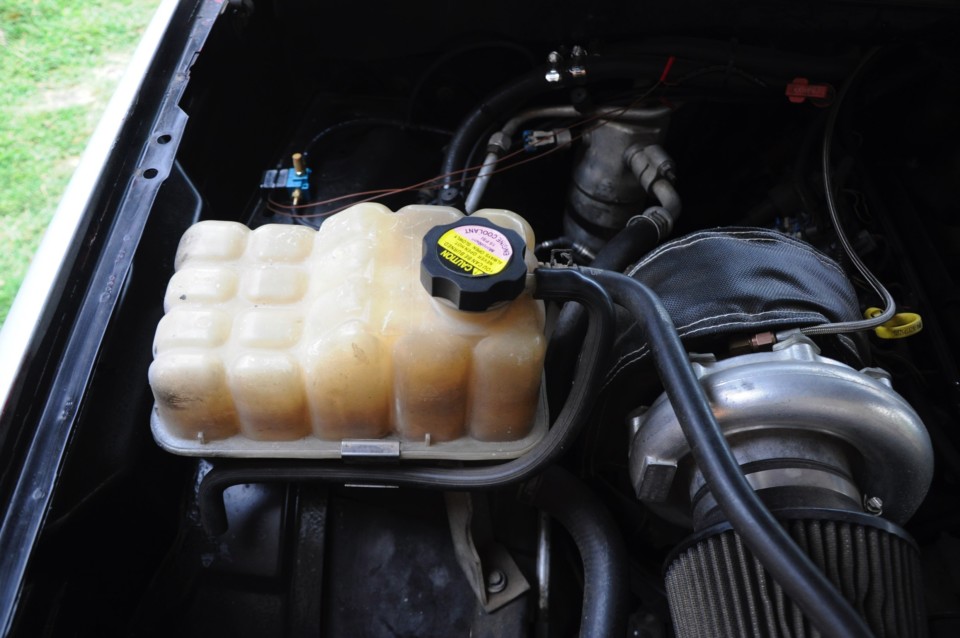Back in the 1960s and ’70s, cars were made out of mostly metal — with a few plastic pieces here and there. They were built to last in a time where weight and fuel mileage didn’t affect the design of the automobile. Fast forward to 2019, and almost everything in or on a car is plastic. Vehicle manufacturers try to make automobiles as light as possible to improve fuel economy and cut down on the cost of the manufacturing process.
Fenders, bumpers, interior, and even engine components are now made of plastic. The only problem is: over time plastic becomes very brittle and weathered, and will eventually breakdown under the elements. What was once a clean, presentable part has now turned into an ugly, yellow, dingy component due to age and excess heat.

Our factory coolant tank in our 2000 Silverado is discolored, cracked, and needs to be replaced. Rather than using another plastic OEM unit, we decided to give Moroso a call.
When plastic parts start to break down, you can either buy a factory replacement, which will end up in the same situation at some point, or you can look to the aftermarket. We chose the latter, as we needed a new coolant tank for our 2000 Chevrolet Silverado and gave Moroso a call. Moroso has been around since 1968 and makes some of the best parts for racecars and street vehicles alike. With over 50 years under its belt and over 4,000-plus products available, you can rest assured that they have parts you need.
As you know, an engine generates a lot of heat under the hood. If you look in the engine bay of just about any modern car, you will notice that most if not all of the coolant reservoirs are made of plastic. In the case of our 19-year-old Silverado, the coolant tank has seen much better days. It was discolored, broken, and starting to seep coolant during long drives. We could have gotten a new factory unit, but with the addition of a 76mm turbo placed next to it, we decided plastic is not the best choice. Plus, we wanted something that looks better than the plastic OEM part.
Moroso had just the part we were looking for, and several other LS applications, as well. It offers replacements tanks made out of aluminum for the 2016 and later Camaro, the Cadillac ATS (2013-present), Cadillac CTS (2014-present), 2005-2013 Corvette, 1997-2004 Corvette, and General Motors pickups and Sport Utility Vehicles for years 1999-2016.
Plastic coolant tanks fail after repeated high-heat situations. – Thor Schroeder
We talked to Thor Schroeder, marketing and new product manager of Moroso about the tanks. Thor states, “Plastic coolant tanks fail after repeated high-heat situations. They discolor and become ugly, whereas the Moroso aluminum coolant tanks can be polished, chromed, powdercoated, or left as-is for a race look.”
After Thor confirmed all of our thoughts, we placed an order to get one on the way.
The Moroso coolant tank is made of aluminum and looks much nicer than the factory part. Not only will it look better under the hood, but it's also built to last, even with a 76mm Trick turbo parked right next to it.
The installation of the Moroso tank is super simple as it is a direct bolt-on. Typically, you would want to drain the coolant before starting the installation. In our case, since the unit was cracked, we were able to skip this step due to lack of fluid. We removed the hoses connected to the two-piece plastic tank and then removed two 10mm bolts.
Next, we bolted-in the new Moroso aluminum tank using the existing 10mm bolts. We hooked up the two coolant hoses and reinstalled the clamps. It only took about 25 minutes to install everything. You can also install a Moroso coolant level sensor, which is offered through the company if you want to monitor the fluid level.
The Installation of the Moroso coolant tank was a breeze and only took a few minutes. The unit even comes with a fluid level sensor so you know if you need to add coolant.
With the unit in place, we no longer need to worry about that pesky heat from our turbo cooking the plastic. The aluminum tank not only looks great under the hood, but it is also very functional and built with the best materials.
Moroso’s craftsmanship is second to none, and we wouldn’t dare powdercoat or paint over the beautiful welds. It’s the little things that also set Moroso apart from other manufacturers on this product, too. The coolant tank bolted right in place using existing hardware. The factory cap even screwed with no modifications or problems. We wish all aftermarket products were this easy and nice to install.
For more information on the Moroso aluminum coolant tank and other performance products, head over to Moroso.com.
























